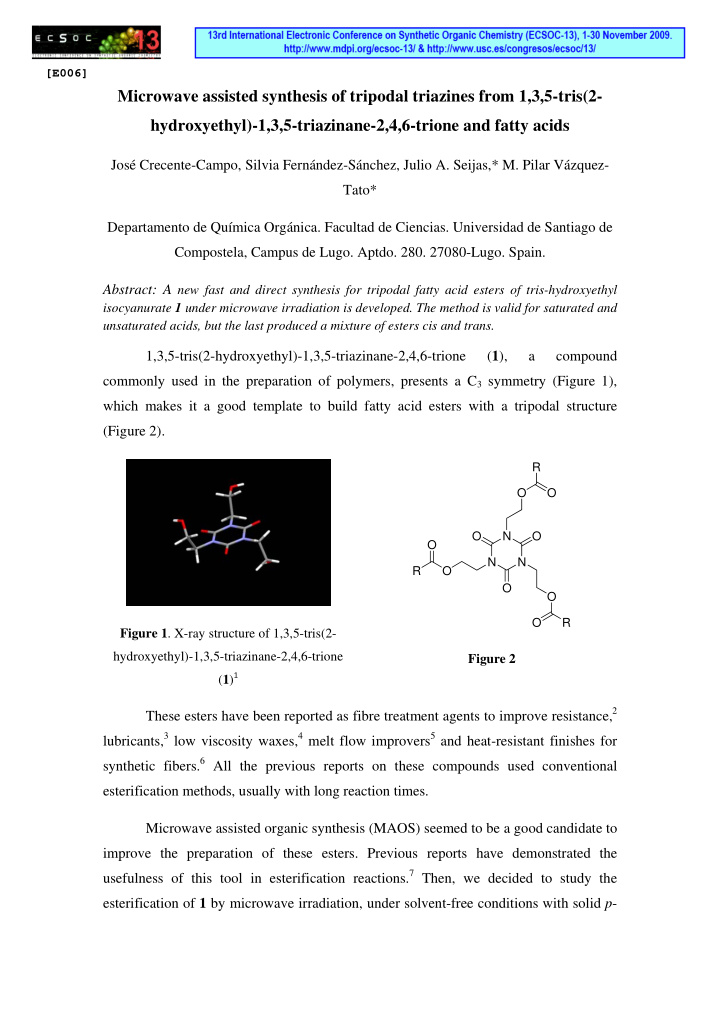



[E006] Microwave assisted synthesis of tripodal triazines from 1,3,5-tris(2- hydroxyethyl)-1,3,5-triazinane-2,4,6-trione and fatty acids José Crecente-Campo, Silvia Fernández-Sánchez, Julio A. Seijas,* M. Pilar Vázquez- Tato* Departamento de Química Orgánica. Facultad de Ciencias. Universidad de Santiago de Compostela, Campus de Lugo. Aptdo. 280. 27080-Lugo. Spain. Abstract: A new fast and direct synthesis for tripodal fatty acid esters of tris-hydroxyethyl isocyanurate 1 under microwave irradiation is developed. The method is valid for saturated and unsaturated acids, but the last produced a mixture of esters cis and trans. 1,3,5-tris(2-hydroxyethyl)-1,3,5-triazinane-2,4,6-trione ( 1 ), a compound commonly used in the preparation of polymers, presents a C 3 symmetry (Figure 1), which makes it a good template to build fatty acid esters with a tripodal structure (Figure 2). R O O O N O O N N R O O O R O Figure 1 . X-ray structure of 1,3,5-tris(2- hydroxyethyl)-1,3,5-triazinane-2,4,6-trione Figure 2 ( 1 ) 1 These esters have been reported as fibre treatment agents to improve resistance, 2 lubricants, 3 low viscosity waxes, 4 melt flow improvers 5 and heat-resistant finishes for synthetic fibers. 6 All the previous reports on these compounds used conventional esterification methods, usually with long reaction times. Microwave assisted organic synthesis (MAOS) seemed to be a good candidate to improve the preparation of these esters. Previous reports have demonstrated the usefulness of this tool in esterification reactions. 7 Then, we decided to study the esterification of 1 by microwave irradiation, under solvent-free conditions with solid p -
toluenesulfonic acid as catalyst. Thus, a 1:3 mixture of 1 and decanoic acid together with a catalytic amount of TsOH (1.67 mol%) were heated to 160ºC for 10 minutes yielding 2,2',2''-(2,4,6-trioxo-1,3,5-triazinane-1,3,5-triyl)tris(ethane-2,1-diyl) tris(decanoate) ( 2 ) in 85%. (Scheme 1). n OH O O O N O O + p -TsOH, 1.67 mol% O N O N N O OH n HO 160ºC, MW N N O O OH O n O 1 n= 7, T= 160ºC n O n=15, T= 110ºC 2 , n=7, 85% 3 , n=15, 52% Scheme 1 Under the same reaction conditions stearic acid suffered pyrolysis. Thus, temperature was decreased in steps of 10 degrees, finding that at 110ºC there was no carbonization yielding, after 20 minutes, a 52% of 2,2',2''-(2,4,6-trioxo-1,3,5-triazinane- 1,3,5-triyl)tris(ethane-2,1-diyl) tristearate ( 3 ) (Scheme 1). In order to check the stability of double bonds oleic acid ((9Z)-Octadec-9-enoic acid) was studied. Irradiation for 30 minutes at 160ºC yielded 68% of a mixed triester of elaidic ( trans ) and oleic ( cis ) acids as detected by 1 H NMR (Figure 3), in an approximated ratio of 2:1, which could correspond to (9E,9'E)-2,2'-(5-(2-((Z)-nonadec- 9-enoyloxy)ethyl)-2,4,6-trioxo-1,3,5-triazinane-1,3-diyl)bis(ethane-2,1-diyl) dioctadec- 9-enoate where 1 is esterified with two molecules of elaidic acid and one of oleic acid.
6 6 O HO O O O OH O N N N N p -TsOH, 5% mol + 6 6 O O N O COOH O N O 160ºC, MW oleic acid 4 OH O O 6 6 Scheme 2 H H H H H H H H 2.1 2.0 1.9 1.8 5.5 5.4 5.3 5.2 Chemical Shift (ppm) Chemical Shift (ppm) Figure 3 In summary, we developed a new fast and direct synthesis for tripodal fatty acid esters of tris- hydroxyethyl isocyanurate 1 . This allows easy access to this kind of compounds in order to study their properties as lipid analogues (Figure 4).
Trigliceride C 18 Compound 4 Figure 4. Molecular lipophilic potential 8 Acknowledgements XUNTA DE GALICIA for financial support: PGIDIT05PXIB26201PR and USC for a predoctoral fellowship to JCC. General experimental procedure Compound 1 ( 0.199 g, 0.76 mmol) thoroughly mixed with decanoic acid (0.408 g, 2.28 mmol) and p -TsOH (7.3 mg), was irradiated in a CEM Discover monomode oven for 10 minutes (200W, 160ºC). The crude reaction was dissolved in CH 2 Cl 2 and washed with NaOH aq (10%) and water. After evaporation the residue was purified by chromatography on silica column, yielding 2 (0.473 g, 85%) as a thick oil. 1 Chong, S. Y.; Seaton, C. C.; Kariuki, B. M.; Tremayne M. Acta Crystallogr. ,Sect. B: Struct. Sc. 2006 , 62 , 864. 2 Yamakita, H.; Ito, Y. Japan Patent JP 2008163489, 2008 , Scifinder CAN 149:202523, 2008 . 3 Gan, X.; Qiu, S.; Lu, X.; Zhang, Z.; Wang, G.; Hu, Z.; Zhang, D.; Xing, Y. China Patent CN 1583985, 2005 , Scifinder CAN 144:54123, 2005 . 4 Kitamura, T.; Doi, K. Japan Patent 1992 JP 04246589, Scifinder CAN 118:149815 1993
5 Nakayama, Y. Japan Patent JP 04248867 1992, Scifinder CAN 118:170302 1993 6 Kitamura, K.; Hosomi, H. Japan Patent JP 62125079, 1987, Scifinder CAN 107:238521, 1987. Minagawa, M.; Nakahara, Y. Japan Patent JP 48071444, 1973, Scifinder CAN 80:60580, 1974. 7 “Microwaves in organic synthesis” 2 nd edition, A. Loupy ed. Wiley-VCH, 2006. Sivan Velmathi, Nagahata, R.; Sugiyama, J.; Takeuchi K. Macromol. Rapid Commun. 2005 , 26 , 1163–1167. 8 Surface calculated with software VEGA ZZ. Pedretti, A.; Villa, L.; Vistoli, G. J. Comp.-Aid. Mol. Design. , 2004 , 18 , 167-173. Pedretti, A.; Villa, L.; Vistoli, G. J. Mol. Graph., 2002 , 21 , 47-49. Pedretti, A.; Villa, L.; VistoliTheor G. Chem. Acc ., 2003 , 109, 229-32. http://www.ddl.unimi.it. The Molecular Lipophilicity Potential ( MLP ) is calculated projecting the Broto-Moreau lipophilicity atomic constants on the molecular surface (Gaillard, P.; Carrupt, P.A.; Testa, B.; Boudon, A. J. Comp.-Aid. Mol. Design., 1994 , 8, 83) .
Recommend
More recommend